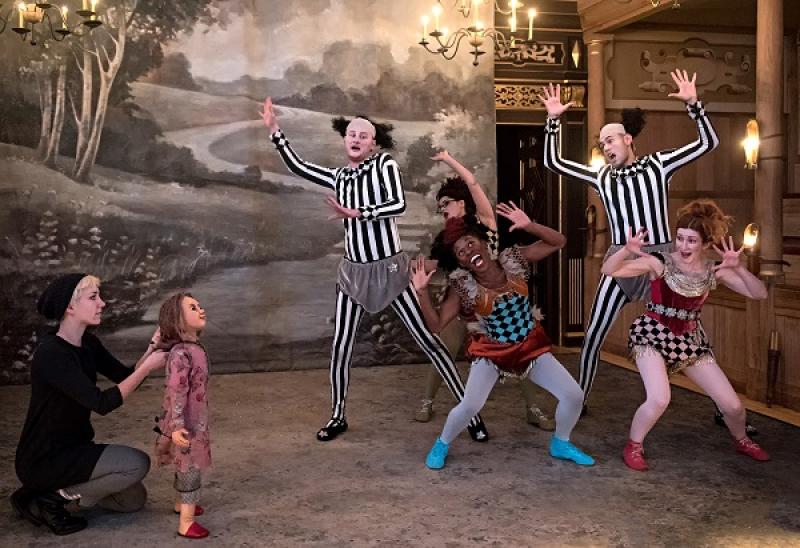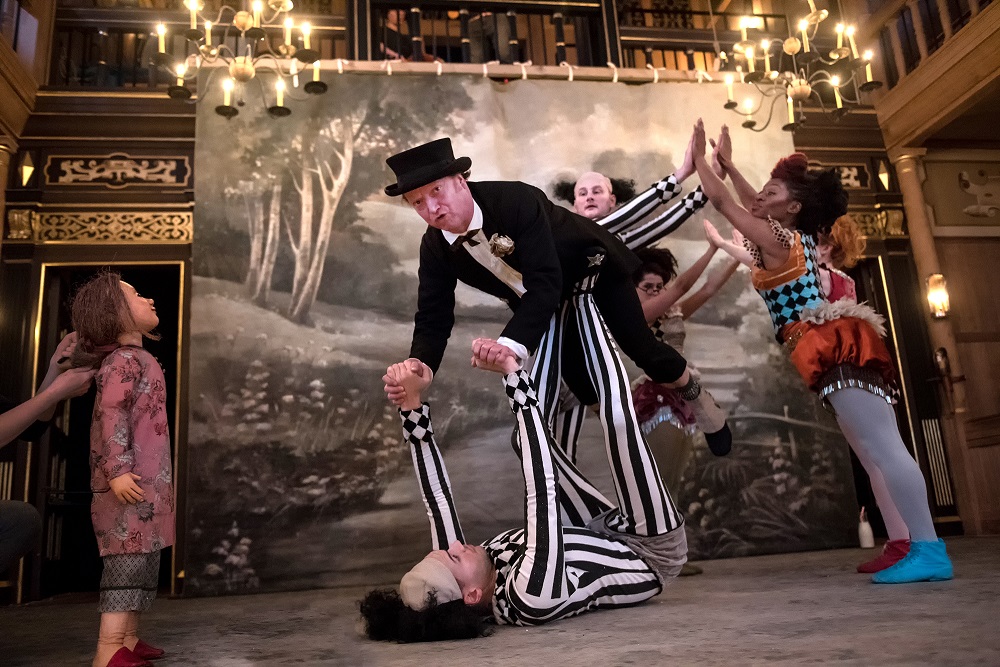The Little Matchgirl, Sam Wanamaker Playhouse | reviews, news & interviews
The Little Matchgirl, Sam Wanamaker Playhouse
The Little Matchgirl, Sam Wanamaker Playhouse
Hans Christian Andersen made contemporary, infused with Emma Rice's trademark brio

For anyone disposed to treat the Sam Wanamaker Playhouse as hallowed ground – and such issues have gained much currency at the Globe recently following the announced early departure of artistic director Emma Rice – The Little Matchgirl may seem like a wanton deconstruction of its space, which is cheeked into a knowing update that comes close to Edwardian music hall, and with aperçus stingingly relevant to the venue’s recent backstory (“Candles are much more atmospheric than
Happiness for Andersen, in life as well as literature, was a very relative thing, and “The Little Matchgirl” must surely be one of the saddest stories ever written, if we disregard its faux-redemptive Victorian ending. Rice, who co-adapted this show with Horwood, creates a world defined by a sense of damage as much as anything else, where strangers bring threat rather than potential comfort. Not least in the opening scene which introduces the title character – the Matchgirl is a puppet whose soulful face conveys more than anything pained bewilderment, skilfully brought to life by puppeteer Edie Edmundson (pictured below) – who seems to be growing up in a warzone. It's a landscape that feels uncomfortably close to home (the conflicts of the former Yugoslavia come to mind), and later morphs into a refugee camp; both are environments in which the idea of extending assistance to the helpless seems painfully absent, while the threat of exploitation or abuse is omnipresent. When help does seem to be offered – by a soldier figure in that first scene: benign or sinister, we are left to wonder – it comes with strings attached. As Thumbelina later discovers, “No such thing as free.”
Horwood’s rhymed verse strides along, enjoying its demotic poetry
The counterpoint to this world where survival, living “for now”, depends on luck, is escape. In Andersen’s story, each match that the Matchgirl strikes brings her not only warmth but also momentary transportation into the imagination, “a place to dream in”. Infused with the writer’s spirit (more than his letter), Horwood’s adaptation introduces the figure of Ole Shuteye (Paul Hunter, rambunctious, pictured bottom, centre), from another Andersen story, as an impresario-compère whose vaudeville company plays out each such excursion (into a new Andersen story). His troupe is completed, we shouldn't omit to mention, by one “Deidre, on loan from Bridlington Rep”, the kind of lovely touch which brings with it a very nice sense of place (Britain) and time (somewhere on the cusp of the Victorian and Edwardian eras).
Vicki Mortimer’s design relishes such period detail and heights of fantasy equally, moderating the formality of the Playhouse with a rural landscape backdrop (which suggests a past tranquillity very lacking from the precarious present inhabited by these protagonists), while running riot with costumes, harlequin black-and-whites set against rich reds. This is never more so than with the fantastical creatures of “Thumbelina” and their elaborate head-pieces: that is the longest, and somehow most organically linked episode, connected to the opening by shared themes of exploitation and escape. Thumbelina (Bettrys Jones, puppeteering her own tiny self) appears in a “makeshift city” – hard not to think of the now-closed Sangatte – and can’t escape the baleful attentions of father and son Toad and Mole. Kyle Lima and Jack Shalloo play (and sing) those two winningly, and are perhaps the most agile shape-shifters in this nimble cast of only six (not counting puppeteer Edmundson), but it’s a close-run thing when movement comes as thick and fast as it does here (choreography, Etta Murfitt). The ensemble playing is near-perfect.
 There’s something of a change of tone as the show moves into “The Emperor’s New Clothes”, a satisfying satire on the vanities of fashion: Jones and Shalloo play a couple of über-camp couturier tricksters, boiler-suited and parodically accented like they’re fresh off an echt-Düsseldorf catwalk, who deliciously outwit Hunter’s deludedly vain Emperor. The closing episode, “The Princess and the Pea”, rather dips in energy and invention after all that.
There’s something of a change of tone as the show moves into “The Emperor’s New Clothes”, a satisfying satire on the vanities of fashion: Jones and Shalloo play a couple of über-camp couturier tricksters, boiler-suited and parodically accented like they’re fresh off an echt-Düsseldorf catwalk, who deliciously outwit Hunter’s deludedly vain Emperor. The closing episode, “The Princess and the Pea”, rather dips in energy and invention after all that.
Horwood’s rhymed verse strides along, enjoying its demotic poetry – which is frequently very funny, sometimes ribaldly so – and sense of the occasional bathos of the form itself: end-rhymes like “lowered expectations/see nations”, or “making a statement/beyond abatement” relish their incongruity. Stephen Warbeck’s score, ranging from oud to double bass, is no less inventive, and he’s credited with additional lyrics too, which suggests that textual collaboration, together with Rice, was close all round. If Brecht and Weill were writing today, The Little Matchgirl is just the kind of Songspiel they might come up with.
 The piece's achievement is to combine delirious imagination of structure with a keen sense of being anchored in a distinctive reality, one to which the show finally returns. Invention is over, revels ended, and we are back on the unforgiving streets, “poetry” only one letter away from “poverty”. There’s surely another presence here, too, none other than Dickens (whom Andersen revered), whose appeals to human empathy are familiar. You might even trace it all back to the end of the RSC’s legendary Nicholas Nickleby, except that we’re in a bleaker world now, one where “happy endings are past.”
The piece's achievement is to combine delirious imagination of structure with a keen sense of being anchored in a distinctive reality, one to which the show finally returns. Invention is over, revels ended, and we are back on the unforgiving streets, “poetry” only one letter away from “poverty”. There’s surely another presence here, too, none other than Dickens (whom Andersen revered), whose appeals to human empathy are familiar. You might even trace it all back to the end of the RSC’s legendary Nicholas Nickleby, except that we’re in a bleaker world now, one where “happy endings are past.”
There will be no happy ending for the idea of a winter season family show at the Globe either, given Rice’s pending departure: it will be the venue’s loss. Despite all the fun of upstaging the conventions that come with the Sam Wanamaker Playhouse, including dropping chandeliers and embracing the upper gallery – not to mention the conceit of a play about lighting matches staged in a candlelit space – I couldn’t but wonder whether The Little Matchgirl might actually come across even better at, say, the Lyric, Hammersmith (where Horwood has presented a number of past Christmas shows). The show’s spirit somehow begs for a somewhat more democratic ambience.
rating
Explore topics
Share this article
Add comment
The future of Arts Journalism
You can stop theartsdesk.com closing!
We urgently need financing to survive. Our fundraising drive has thus far raised £49,000 but we need to reach £100,000 or we will be forced to close. Please contribute here: https://gofund.me/c3f6033d
And if you can forward this information to anyone who might assist, we’d be grateful.

Subscribe to theartsdesk.com
Thank you for continuing to read our work on theartsdesk.com. For unlimited access to every article in its entirety, including our archive of more than 15,000 pieces, we're asking for £5 per month or £40 per year. We feel it's a very good deal, and hope you do too.
To take a subscription now simply click here.
And if you're looking for that extra gift for a friend or family member, why not treat them to a theartsdesk.com gift subscription?
more Theatre
 The Maids, Donmar Warehouse review - vibrant cast lost in a spectacular-looking fever dream
Kip Williams revises Genet, with little gained in the update except eye-popping visuals
The Maids, Donmar Warehouse review - vibrant cast lost in a spectacular-looking fever dream
Kip Williams revises Genet, with little gained in the update except eye-popping visuals
 Ragdoll, Jermyn Street Theatre review - compelling and emotionally truthful
Katherine Moar returns with a Patty Hearst-inspired follow up to her debut hit 'Farm Hall'
Ragdoll, Jermyn Street Theatre review - compelling and emotionally truthful
Katherine Moar returns with a Patty Hearst-inspired follow up to her debut hit 'Farm Hall'
 Troilus and Cressida, Globe Theatre review - a 'problem play' with added problems
Raucous and carnivalesque, but also ugly and incomprehensible
Troilus and Cressida, Globe Theatre review - a 'problem play' with added problems
Raucous and carnivalesque, but also ugly and incomprehensible
 Clarkston, Trafalgar Theatre review - two lads on a road to nowhere
Netflix star, Joe Locke, is the selling point of a production that needs one
Clarkston, Trafalgar Theatre review - two lads on a road to nowhere
Netflix star, Joe Locke, is the selling point of a production that needs one
 Ghost Stories, Peacock Theatre review - spirited staging but short on scares
Impressive spectacle saves an ageing show in an unsuitable venue
Ghost Stories, Peacock Theatre review - spirited staging but short on scares
Impressive spectacle saves an ageing show in an unsuitable venue
 Hamlet, National Theatre review - turning tragedy to comedy is no joke
Hiran Abeyeskera’s childlike prince falls flat in a mixed production
Hamlet, National Theatre review - turning tragedy to comedy is no joke
Hiran Abeyeskera’s childlike prince falls flat in a mixed production
 Rohtko, Barbican review - postmodern meditation on fake and authentic art is less than the sum of its parts
Łukasz Twarkowski's production dazzles without illuminating
Rohtko, Barbican review - postmodern meditation on fake and authentic art is less than the sum of its parts
Łukasz Twarkowski's production dazzles without illuminating
 Lee, Park Theatre review - Lee Krasner looks back on her life as an artist
Informative and interesting, the play's format limits its potential
Lee, Park Theatre review - Lee Krasner looks back on her life as an artist
Informative and interesting, the play's format limits its potential
 Measure for Measure, RSC, Stratford review - 'problem play' has no problem with relevance
Shakespeare, in this adaptation, is at his most perceptive
Measure for Measure, RSC, Stratford review - 'problem play' has no problem with relevance
Shakespeare, in this adaptation, is at his most perceptive
 The Importance of Being Earnest, Noël Coward Theatre review - dazzling and delightful queer fest
West End transfer of National Theatre hit stars Stephen Fry and Olly Alexander
The Importance of Being Earnest, Noël Coward Theatre review - dazzling and delightful queer fest
West End transfer of National Theatre hit stars Stephen Fry and Olly Alexander
 Get Down Tonight, Charing Cross Theatre review - glitz and hits from the 70s
If you love the songs of KC and the Sunshine Band, Please Do Go!
Get Down Tonight, Charing Cross Theatre review - glitz and hits from the 70s
If you love the songs of KC and the Sunshine Band, Please Do Go!
 Punch, Apollo Theatre review - powerful play about the strength of redemption
James Graham's play transfixes the audience at every stage
Punch, Apollo Theatre review - powerful play about the strength of redemption
James Graham's play transfixes the audience at every stage

Comments
It was the RSC that did
Thank you - already changed